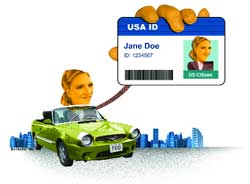RFID in the cards at the border?


Connecting state and local government leaders
The recent extension of radio frequency identification testing at border crossings would seem to boost the prospects for getting widespread systems in place. But the Homeland Security Department still faces significant hurdles in integrating, particularly for border crossing, RFID applications and standards, government officials and IT experts said.

There is a drive to develop a common RFID standard for all border crossing identification cards, but one of the main challenges is harmonizing different privacy considerations that apply to holders of each type of card.
Ultrahigh-frequency RFID, which permits readings of information at up to 60 feet away, could spark the greatest privacy concern.
'It has the potential for quickly identifying American citizens in a crowd,' said P.T. Wright, a Homeland Security official involved in RFID card development, in response to a question at a FOSE trade show presentation last month.
The U.S. Visitor and Immigrant Status Indicator Technology (U.S. Visit) program can read RFID-enabled documents 35 feet away in tests. To safeguard privacy, the RFID documents transmit only a series of numbers, which must be matched to a database to identify a person.
Privacy protection
But the upcoming People Access Security Service card, referred to as the PASS card, which will be issued to U.S. citizens who frequently cross the borders with Canada and Mexico, is likely to have different privacy considerations.
Like the RFID-enabled e-passport it resembles, the card, which DHS and the State Department will issue, can contain personal information. If the PASS card is RFID-enabled'and no decision has been made yet'it could require greater privacy protections and a more restrictive reading distance to protect privacy.
At a recent Senate hearing, DHS secretary Michael Chertoff said the agency was pushing to develop a single RFID standard for border crossing cards, including not only U.S. Visit and PASS, but possibly the Mexican 'laser visa' Border Crossing Card, Nexus and Sentri trusted-traveler cards and the Free and Secure Trade commercial truck driver identification cards.
Sen. Patrick Leahy (D-Vt.) asked Chertoff why, in moving toward a single border crossing card, the department appears to be supporting the ultrahigh-frequency RFID standard instead of the e-passport standard.
'I don't think a decision has been made,' Chertoff said. 'I've talked to Secretary [Condoleezza] Rice about this, and I think we've both agreed that we actually ought to migrate to a common standard ... I want to have a chip, some kind of RFID chip, that is compatible, whether we do it in a passport or in a border crossing card or in some other kind of card.'
The primary reason for moving to a single RFID-enabled card or document is efficiency, to avoid having multiple cards and readers at the border ports.
'You won't be carrying five cards,' said Wright, director of mission operations for U.S. Visit. 'We're looking to the future.'
But integrating the DHS border-crossing cards could be a slow and difficult process because of thorny privacy issues and because the government already has invested in particular technologies.
'There are some significant policy issues involved,' said a federal official who is involved in the RFID discussions, but who declined to be identified because of the sensitivity of the issues. 'It's not close to being resolved.'
State's e-passport plan sparked controversy for months when it was first introduced, because of privacy concerns. Additional security features addressed the problem. A similar fate could await a harmonized RFID border-crossing card.
In U.S. Visit testing, the RFID chips, which are tiny microprocessors, have been embedded in travel documents issued to about 200,000 foreign visitors at five entry ports in Arizona, New York and Washington states since the tests began last year.
A reader 35 feet overhead wirelessly scans the documents while visitors leave the United States in their vehicles. Readers mounted several feet away along traffic lanes again scan the documents when visitors re-enter the country.
Additional tests
The department this summer will begin a second phase of tests to see if dozens of the RFID-enabled travel documents can be read simultaneously at high speeds, and to see if the documents can be matched efficiently with vehicle license plates.
'In the future, the entry ports could look like toll plazas,' Wright said.
The tests have shown that the RFID documents can be read accurately when the cars are moving at speeds of up to 50 miles per hour, said Bill Hartwell, a vice president of Symbol Technologies Inc. of Holtsville, N.Y., whose RFID system is being tested in U.S. Visit.
'In some cases, eight lanes of traffic are being scanned,' he said.
Alice Lipowicz is a staff writer for GCN's sister publication, Washington Technology.
NEXT STORY: SIM city and the network




